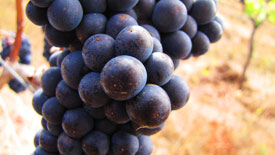Dayton, Oregon. Perhaps, breweries and distilleries have it easier in certain respects. Their production runs occur repeatedly throughout the year, and are also far less subject to the whims and alternating forces of raw nature.
Not so for a winery.
As a second-generation owner, Alex Blosser, co-president of Sokol-Blosser Winery says of their annual Fall harvest that usually lasts 3-4 weeks,
“we have one shot to do it in the wineries, in the vineyards, if we mess it up, we have to wait another year. So harvest time is extremely intense because you don’t want to mess it up. There’s limited control, the grapes get picked when they decide to get picked. Not so much when we decide to pick, when the grapes are mature and ripe, that’s when we want to pick them.”
The Sokol-Blosser Winery is located in the Dundee Hills, one of six sub-AVA’s within the Willamette Valley. Renowned as a region for the growing of pinot noir grapes, the combination of warm days and cool nights, and suitable soil types provides one of the few ideal environments in the world for growing these grapes. Sub-AVA’s reflect subtle differences between micro-regions. The Dundee Hills, for example, are largely on volcanic soil which tends to produce more red fruit tones in the pinot noir. By contrast, next door Yamhill-Carlton sub-AVA, produces more black fruit tones as a result of their marine sedimentary soil. Mr. Sokol Blosser is quick to point out though, these are both broad generalizations.
According to the Sokol Blosser’s, only one harvest was a wash out for the certified organic winery: 1984. That year, they did not produce any pinot noir wines, just rosé and blanc style wines. As of 2011, asked which years stood out as among their finest vintages, they mentioned: 1983; 1985; 1999; and 2005.
When do you know when a particular vintage is going to stand out from other years?
Says Alex Sokol Blosser, “you know a little bit at the time of picking, because at the time of picking you know well, are you picking because it’s fully mature and ripe, or are you picking because it’s pouring down rain, and you got no choice but to pick because it’s going downhill. So, at the time of picking, you can be either in a good spot or a bad spot.”
… “During fermentation, you can smell the fermentation, you can see the color, what the color is doing”, you can find out if it’s balanced in terms of (ph) acidity, and then when it goes in the barrel. “You see the color looks great, it tastes solid.”
“We’ll do the final blending for the 2010 vintage in December (2011), that’s when we will know how good the vintage is. So, it’s really a full year after— when we’ll be able to say— we got a franchise player, or this guy’s going to be a good position player.”
Being second generation owners has a lot to do with the size of the winery. In Oregon, there are about 400 wineries, and on average they each produce 5000 cases annually. Much like the Burgundy region of France, most of the wineries are small operations run by the local owner and managers, and not third-party investments run largely for financial profit. While the financial bottom-line is critical for the long-term viability of any business, profit is not the only measure of success to a number of Oregon wineries. Oregon winemakers also care deeply about their local community, and recognize that their success in the global marketplace, in part, stems from the growing awareness of the quality of Oregon wines in general. The ability to pass down to the next generation a way of life, and a livelihood is also of tremendous importance to winemakers like the Sokol Blosser’s.
Small Oregon wine producers may only produce 1% of the total U.S. annual wine production, in aggregate. Nonetheless, they are able to stand together and to stand out from the crowd.
That’s quite an achievement.
Visit Yamhill Valley Wines for their “Wines of the Valley” series that features the history, quality and diversity of the Yamhill Valley’s flourishing wine industry. For the introductory video, along with the video series list, check out the first post on CUPS: The Yamhill Valley Wine Region of Oregon
Most of the videos featured on Cooking Up a Story were produced, filmed, and edited by Rebecca Gerendasy. Fred Gerendasy contributed as a writer to many of the posts and occasionally as the interviewer. Visit Rebecca Gerendasy Clay – Art and Fred Gerendasy Photography to see their current work.



